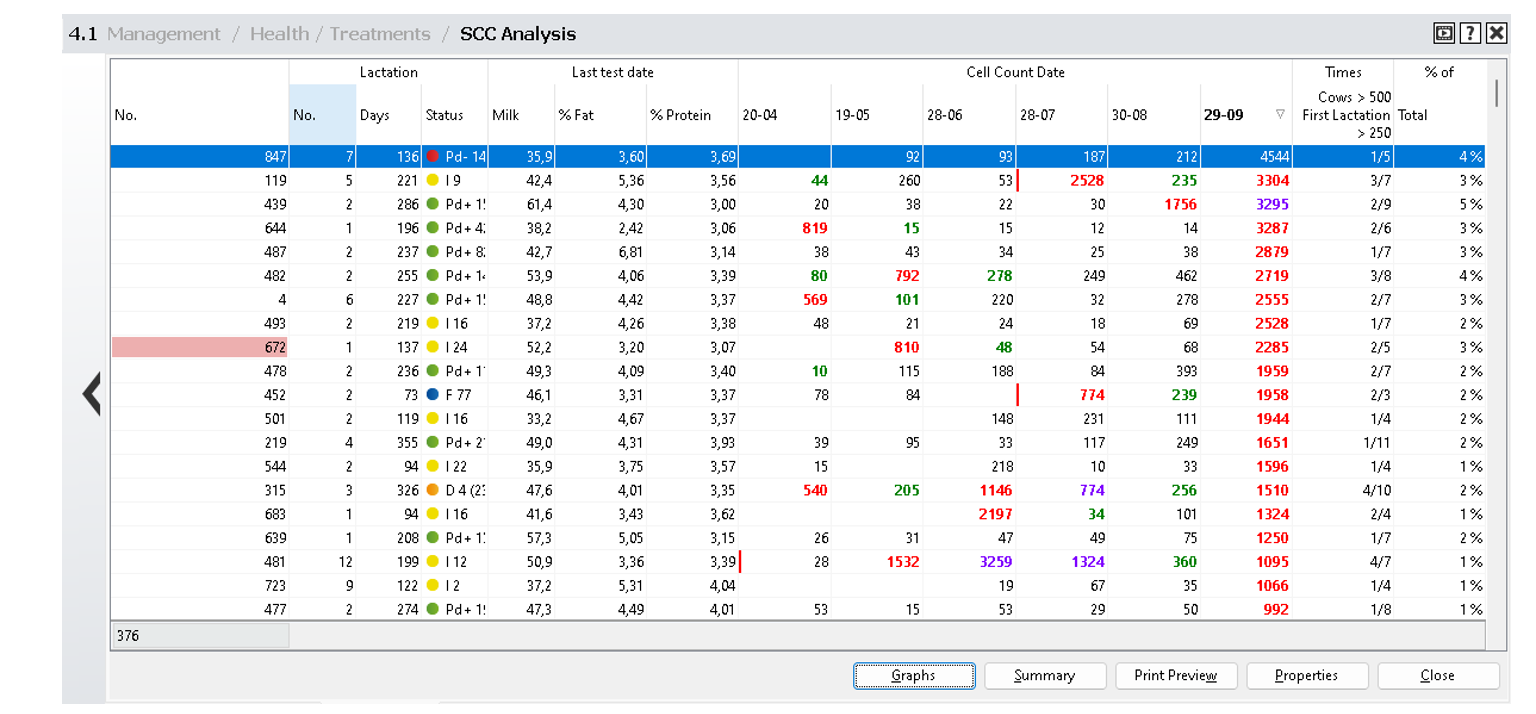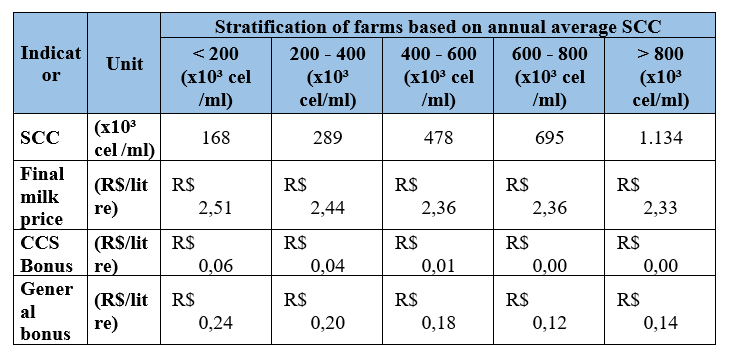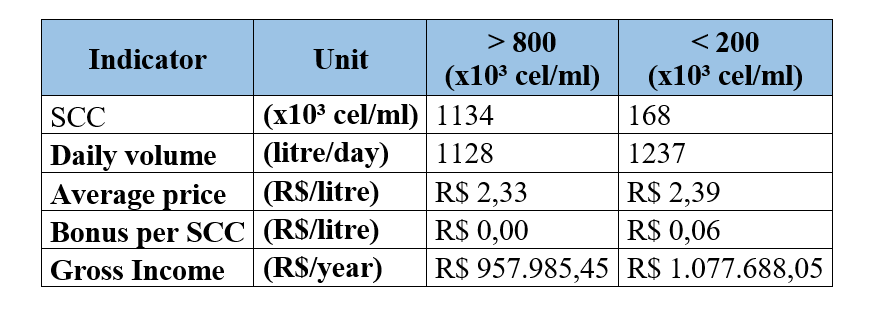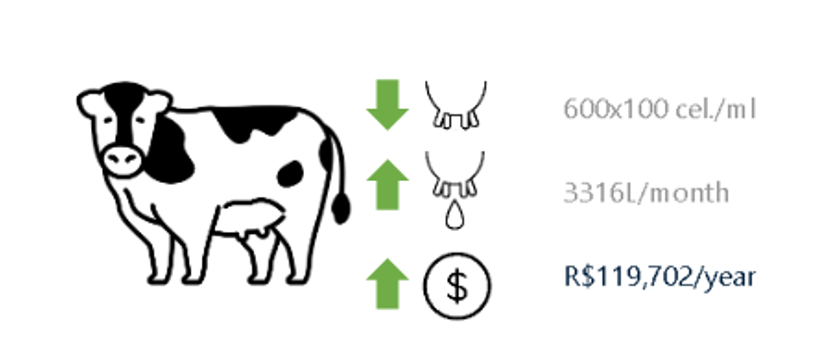Do you know the relation between SCC and Profitability?
A study of dairy farms in Brazil by Labor Rural Intelligence Department
Due to the demands requested by the legislation and the consumers of dairy products regarding milk quality, especially regarding Somatic Cell Count (SCC) and Standard Plate Count (SPC), this subject is increasingly discussed and valued in the dairy chain, leading farmers, industries and consultants to work on the improvement of these indicators. But when we refer to milk quality, especially the SCC, the importance and impact of this indicator go far beyond the requirement to meet the values recommended by legislation, as it reflects the health of the herd and the efficiency of several management measures adopted in the production system.
Brazilian legislation, as determined by Normative Instruction 76 (IN 76), determines that properties must present average monthly SCC results below 500 x 10³ cells/ml of milk, a value that represents balance between animal health and food safety for consumers. However, it is known that in practice farmers still face major challenges to achieve this goal.
In Figure 1, it is possible to identify that only 11% of the 550 properties analyzed by the Department of Intelligence of Labor Rural obtained average annual SCC lower than 200 x10³ cells/ml, reference value used to consider a herd as healthy. And 54% of these properties have average annual SCC lower than 400 x 10³ cells/ml, a value still considered acceptable for herd health. This information shows that although the legislation already requires SCC values lower than 500 x 10³ cells/ml, this is still a challenge in most properties, and it is up to us, professionals and farmers in the dairy chain, to work to control SCC values at those properties.
Figure 1: Percentage of dairy farms categorised in each SCC range

Source: Labor Rural Intelligence Department. Results from 550 properties analysed from January, 2021 to December, 2021.
Figure 2: UNIFORM-Agri SCC Analysis

Source: UNIFORM-Agri
The SCC is an indicator often used in the field because it reflects the impact of the practices adopted in the animals’ health. It is approached by industries because it directly affects the quality of dairy products, impacting in the price paid to farmers and in the acceptance of products by the consumer market. Therefore, milk quality bonus programs are implemented in dairies based on average monthly SCC values, as shown in table 1.
Table 1: Relationship of average annual SCC x the bonification on the milk price

Source: Labor Rural Intelligence Department. Results from 550 properties analysed for the period January/2021 to December/2021. Economic information corrected by the IGP-DI (General Price Index – Domestic Availability) of December/2021.
The properties that presented lower annual SCC average were able to obtain better bonus in the unit price of milk, which contributed to the average price of these farms being 7.7% higher when compared to the price received by the properties that obtained the worst annual SCC average. Besides generating direct bonus for its own result, it is already known that high SCC is associated with alteration in the fat and protein contents of milk (SANTOS, 2019), parameters also used in milk bonus systems. Thus, it is possible to observe that the bonus of the properties with lower average SCC was higher not only by the SCC bonus, but also in the other factors considered for the bonus in the price paid per litre of milk, which shows that these properties tend to have better results of SPC (Standard Plate Count), fat and protein. Thus, we must remember that SCC control also brings financial benefits to the property.
Although the milk price is an important factor for the financial health of the business, it is not determinant for the success of the dairy activity. To obtain positive financial results we need, above all, to pay attention and seek balance in the production cost..Although the milk price is an important factor for the financial health of the properties, it is not determinant for the success of the dairy activity. To obtain positive financial results we need, above all, to pay attention and seek balance in the production cost.
The analysis of table 2 shows as the SCC results of the properties get worse, the higher are the expenses with medication. This is explained by the fact that the higher the SCC results, the greater the chances of occurrence of mastitis and other associated diseases, which leads to high expenses with medication.
When we evaluate the cost of medication per cow (R$/cow in lactation/year), the properties with SCC average < 200 x 10³ cells/ml present higher expenses, R$ 509.34/cow/year, than the other categories. R$ 381.75/cow/year in properties with SCC higher than 800 thousand cells/ml, but this value is watered down when we take into consideration the productivity of animals in these same levels. This happens because the high SCC directly interferes in the productive capacity of animals. It damages the milk producing cells, making the animals with high SCC results tend to lower milk
Table 2: Relation of production cost with the different SCC ranges.

Source: Labor Rural Intelligence Department. Results from 550 properties analysed for the period January/2021 to December/2021. Economic information corrected by the IGP-DI (General Price Index – Internal Availability) of December/2021. *Cost with intramammary for lactating cows.
productivity (liters/cow in lactation/day). On average, properties that present SCC higher or equal to 800 X 10³ cells/ml may have the production capacity of cows reduced in up to 9.7%.
In analysis of the Labor Rural database, it is noticed that if the properties belonging to the SCC stratum > 800 x 10³ cells/ml improved this result to < 200 x 10³ cells/ml it would be possible to obtain:
- Productivity (litres/lactating cow/day) of up to 17.5 l/VL/day;
- SCC bonus of approximately R$0.06/litre;
- Gross income of R$119,702.59/year more than that obtained with SCC >800 x 10³ cells/ml.
All these points would happen because the SCC reduction leads to better productivity of cows, higher bonus for milk quality and, consequently, higher annual gross income, as exemplified in Table 3.
Table 3: Simulation of indicators after reduction of SCC to <200 x 10³ cells/ml

Source: Labor Rural Intelligence Department. Simulation based on the results of 550 properties analysed for the period January/2021 to December/2021. Economic information corrected by IGP-DI (General Price Index – Internal Availability) of December/2021. *Intramammary costs for lactating cows.
Figure 3: Illustration of the impact obtained on monthly production and annual gross income due to the reduction in SCC, as presented in Table 3.

Source: Labor Rural Intelligence Department. Simulation based on the results of 550 properties analysed for the period January/2021 to December/2021. Economic information corrected by IGP-DI (General Price Index – Internal Availability) of December/2021. *Intramammary costs for lactating cows.
As discussed above, SCC impacts milk yields, cow productivity, medication costs and gross milk income. But is it really feasible to invest in the improvement of this indicator? To know if an activity is economically viable we need to evaluate two factors:
- Net margin (NM): is the subtraction of gross income (amounts received for the activity) by the Total Operating Cost (TOC – ratio of direct payments plus the remuneration of family labour and depreciation). It shows the amount of money “left over” for the farmer after having paid all the total operational expenses.
- Rate of return on land capital (TRCC): is the division of the net margin of the activity by the capital stock tied up in machines, improvements, equipment, non-annual fodder crops and land. This is the indicator that shows the profitability of dairy farming and allows comparing its attractiveness with any other activity.
Figure 2: Graph on the Net Margin and the Rate of Return on Land Capital of the properties grouped into the different SCC ranges..

Source: Labor Rural Intelligence Department. Results from 550 properties analysed for the period January/2021 to December/2021. Economic information corrected by the IGP-DI (General Price Index – Internal Availability) of December/2021. *Cost with intramammary for lactating cows.
Analyzing the data in Figure 2, we observe that the properties with high SCC (higher than 800 X 10³ cells/ml) presented worse NM and TRCC results than those with lower SCC (200 x 10³ cells/ml). Therefore, SCC control is directly related to greater economic return, contributing to make dairy farming economically attractive in this scenario.
Although the SCC is not the only determining factor for the property to have good technical and economic results, we can conclude that it is worth investing in the control of this indicator, since it is linked to improved productivity, margins and profitability of the activity.
Therefore, it is our mission to work to improve the SCC of dairy farms and to harvest the good fruits generated by this change!

Author:
Paolla Mara Dellabrida de Andrada Faria
Technical Consultant of Labor Rural
Co-authors:
Christiano Nascif
Director of Labor Rural and Superintendent of Senar Minas
Luisa Carla Cotta
Technical Consultant of Labor Rural

